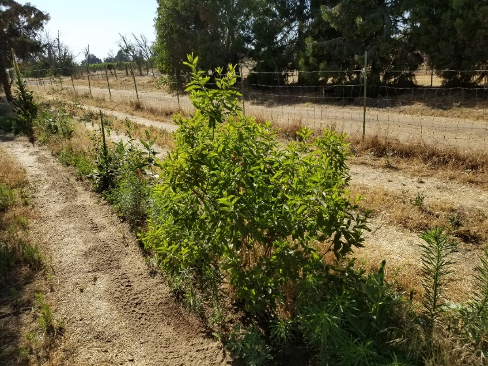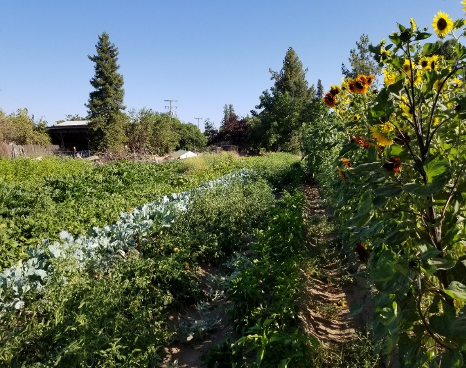Steven Lee, PhD, has worked as the farm manager for Quaker Oaks Farm in Visalia, CA for the past 5 years. This 22-acre nonprofit educational center includes 8 acres of native wetlands, 2 acres of organic mixed vegetable crops, and 1 acre of organic stone fruit and Asian pears.
Steven has been working in agriculture for about 20 years, both in the lab and in the field. In 2017, he applied for the first round of Healthy Soils funding to implement a wide variety of conservation practices. The farm already did reduced tillage, but they used HSP funds to offset the costs of buying compost, planting cover crops, spreading mulch, and installing hedgerows.
He started these practices to improve the health of the soil and benefit the local ecosystem.
Practices
For the orchard, Steven has followed the following schedule:
In the spring, he mows down the cover crops and then applies compost. He spreads wood chips on top of the compost. The mulch has not yet caused a nitrogen deficiency in the fruit trees because it stays on top of the soil and is not thoroughly mixed in. In the fall, he disks the mulch in lightly and seeds the cover crops right before a rain. The cover crop mix he planted last year included triticale, vetch, bell beans, and field peas. However, he prefers planting oats over triticale.
In the vegetable cropping area, he follows a different procedure:
He drives up to Williams, CA in the fall to procure organic straw to maintain the farm's organic certification. He then spreads the straw mulch in the area between the vegetable beds. He found that rice straw was too clumpy to spread easily and thus prefers more traditional oat or wheat straw. He then seeds the cover crops into the mulch. The mulch improves cover crop seed germination, as it provides both moisture and protection from hungry birds. After disking in the cover crops in the spring, he plants his vegetable crops.

Effects
Soil
In just the past 3 years of doing these practices, the soil organic matter has increased from 1% to 2%. However, the soil pH has also gone up from 7 to 7.5. At some point, the increase in organic matter should help buffer and stabilize the soil.
Yield
The total yield has decreased because of the difficulty of incorporating cover crops into the vegetable system schedule. Cover crops and mulch require more work and effort to implement, and Steven and his team of volunteers couldn't get everything done in time. However, for him, the long-term ecological benefits are more important than a season or two of reduced yields.
Pests
The cover crops and hedgerows have led to increased insect diversity. There are more beneficial insects like ladybugs, green lacewings, assassin bugs, praying mantis, along with more pollinators like bees and hoverflies than there were a couple years ago.
However, there are also more ground squirrels, rabbits, and gophers. There are birds of prey and snakes, but not enough – the cover crops offer cover and protection for these pests.
Erosion
The mulch between the vegetable beds has reduced dust emissions, which makes working in the vegetable beds easier.
Water consumption
In both the trees and the vegetable crops, the mulch and compost keeps the soil moist. Steven has only watered the young fruit trees 3 times this year using furrow irrigation and has not seen any ill effects on tree health.
He has reduced his irrigation frequency on his vegetable crops from every other day to once a week. He estimates that he is now using about half the water he was applying before, but still has plenty of produce.
Overall profitability
Steven doesn't need to buy expensive organic blood meal anymore because the cover crops and compost provide enough nutrition. The long-term stabilization of soil productivity through the implementation of these practices should lead to resilience.
One of the difficulties he's had is that the timing for the Healthy Soils Program doesn't always match up with what makes the most sense for vegetable production. He had to skip a whole cycle to plant cover crops, which ended up costing the farm money.
Recommendations
He would recommend implementing these practices if they fit into your system. If you're interested in trying one of these practices, his advice is to keep it simple.
He is cautious about recommending straw mulch in vegetable crops, because he found it to be time-consuming and not cost effective. The biggest benefit for the straw mulch was that it improved cover crop germination. Spreading wood chips on the orchard floor was easier and so he would recommend that more than he would recommend the straw mulch.
His highest praise was for the hedgerows. He pointed out that you can plant herbs like rosemary, oregano, or sage, which would allow you to both sell a product and promote biodiversity.
Improvements
Looking back over the past 3 years, he would improve his implementation of these practices by simplifying and not overcommitting himself. He had better results when he seeded the cover crops between the vegetable beds instead of on the beds themselves.
He would also like to try further reducing tillage and using a roller crimper. This would turn the terminated cover crops into mulch. That way, he wouldn't need to import mulch from another farm.
He's also interested in doing multiple plantings of cover crops, now that the farm has finished its Healthy Soils project and thus will have more flexibility with its scheduling. For example, planting buckwheat, which grows so fast that it can evade drought and attracts beneficial insects.
